Decoding and Comparing Dog Food Labels
12/28/18
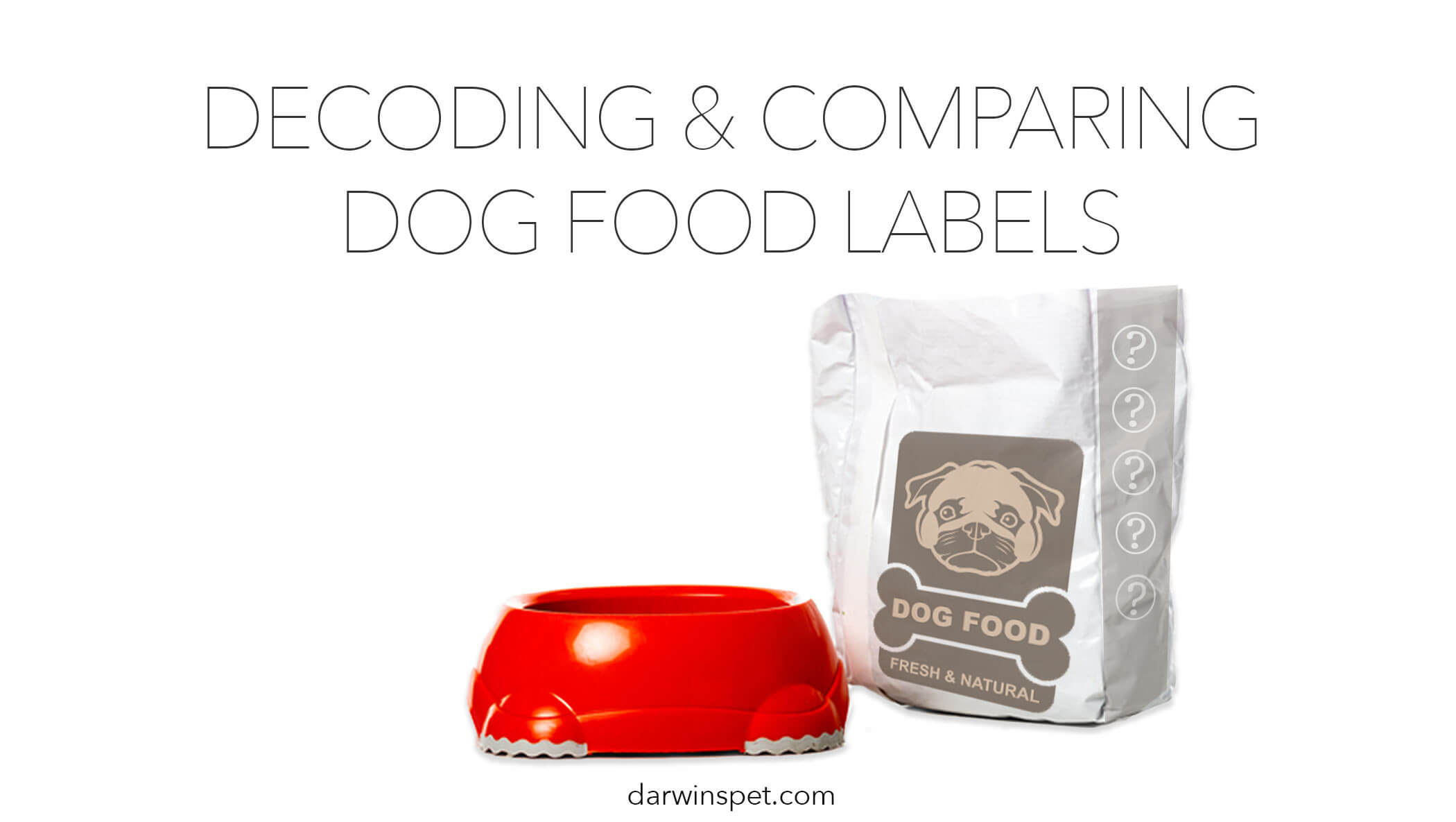
How to Read and Compare Dog Food Labels
Last Updated on
Dog lovers want to provide wholesome food that supports their pet’s health and quality of life. What’s in the food you serve your dog? Is it right for her?
In this article, you’ll learn how to decipher seemingly mysterious dog food labels. Caroline Coile, Ph.D., 2015 Inductee into the Dog Writers Association of America Hall of Fame, a specialist in canine science, health, breeds and competition, and author of 34 books, including the top-selling Barron’s Encyclopedia of Dog Breeds,will provide valuable insights to help you understand dog food labels.
“I’m a big believer that dogs should enjoy their meals, and research has shown they appreciate variety!” comments dog-expert and Dog Mom Coile.
Before you provide that variety, it’s important to understand the exact content of dog food you’re considering buying. That requires an understanding of dog food labels, the regulations that apply to them, and some digging into the ingredients they contain, from protein to preservatives.
What Are Dog Food Labels? Understanding Principle Display and Information Panels
There are two different types of dog food labels. The principal display panel is the marketing-type labeling on the front of the packaging. The second is the information panel, which provides nutritional information written according to regulatory guidelines.
The Principal Display Panel
The colorful, eye-catching principal display panel on the front of the packaging is designed to generate positive feelings and market the product. Research shows that people make purchases for their pets based on emotion, which is why the principal display panel often features an attractive dog, people, impressive information graphics, and fresh-looking food or some combination of all of those elements along with:
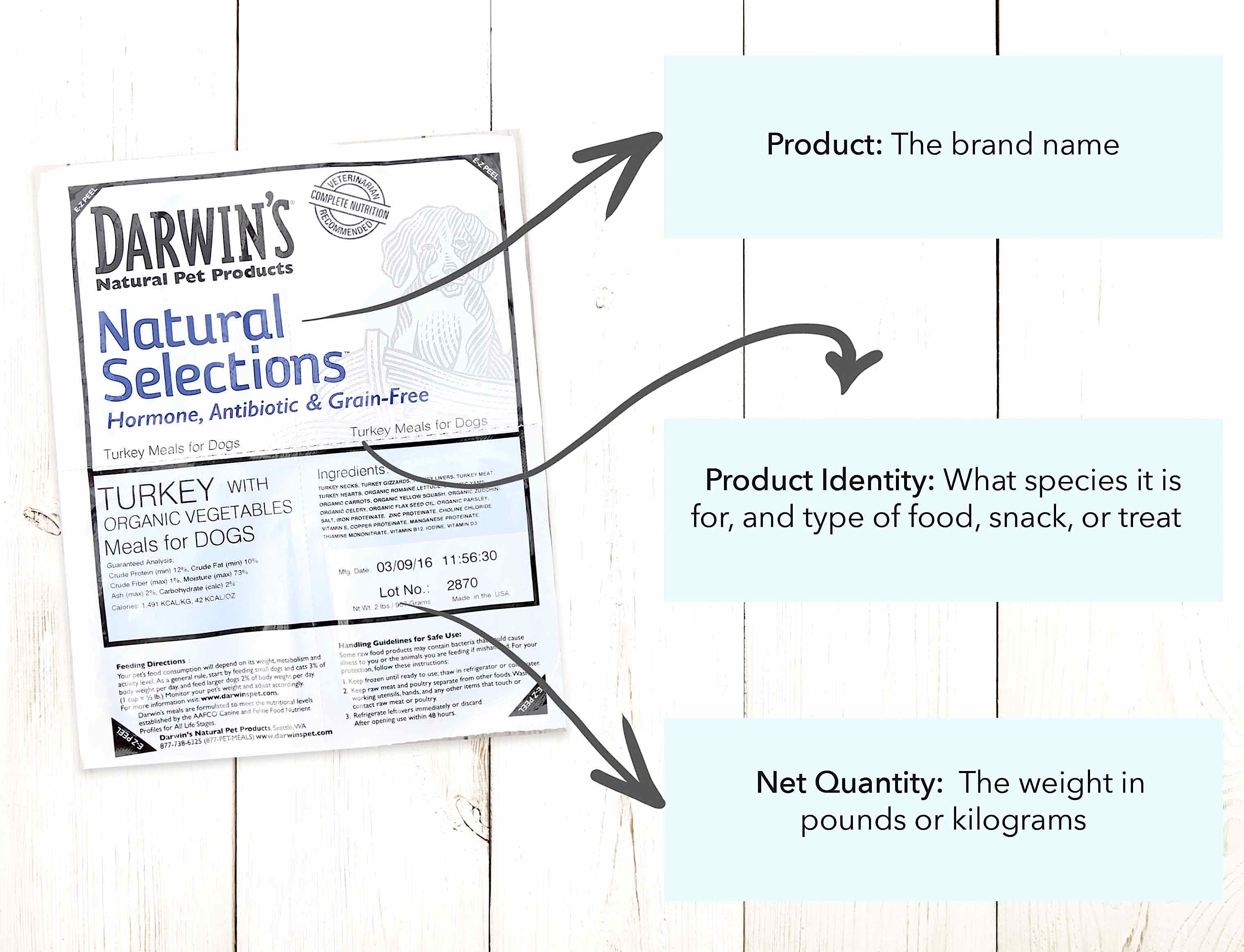
The information panel is essentially a dog food nutrition label and contains details about food ingredients and content percentage. If you buy your dog’s food from a big box, grocery or pet supply store, the information panel may not be in prominent view since this label is typically located on the side or back of package. Basically, the information panel provides concerned pet owners with the information they need to do the following:
- Verify Content: Ensures that the food contains six essential elements: water, protein, carbohydrates, fat, vitamins, and minerals.
- Determine Quality and Suitability: Provides a way for owners to compare products– because no single food product is suitable for every dog.
- Determine Pricing: Understand the cost based on price ratio or cost/weight analysis.
- Check for Pet Allergens: If your dog has food sensitivities (to dairy or wheat, for example), the information panels ensure that you won’t be feeding an allergen to your companion. Learn more about pet allergies and skin conditions by reading All About Dog Skin Allergies & Conditions.
Before we jump into greater detail about what’s displayed on the information panel, let’s look at how pet and dog food labeling is regulated.
Coile emphasizes that when it comes to dog food, “No, you shouldn’t have blind faith.” All pet food labels, including dog food labels, are regulated by governing entities that work together to set regulatory standards and enforce them:

Federal: The United States Food and Drug Administration (FDA), Center for Veterinary Medicine (CVM), and the Federal Trade Commission (FTC)
Enforced by the FDA, federal regulations set the standards that apply to all animal food including product identification, net quantity statements, the producer or manufacturer’s name and address, and ingredient list. These federal regulations are enforced by the CVM. The FTC governs pet food advertising and labeling claims. The FTC can take action against claims that are untruthful or misleading.
The Association of American Feed Control Officials (AAFCO) is an organization consisting of state regulatory officials who develop “model” bills and regulations for pet food. States can then adopt their respective laws and rules. The FDA, a voting member of AAFCO, participates in AAFCO meetings, seminars, and training sessions to help state feed regulators review shared feed issues. Labeling guidelines are set down in AAFCO’s Pet Food and Specialty Pet Food Labeling Guide, which is available for $100. A synopsis of those requirements is available on AAFCO’s labeling and labeling requirements webpage.
Most states have adopted the model pet food regulations established by AAFCO, and these rules are typically regulated and enforced in states by their departments of agriculture. A dog food label is a legal document governed by that body and is the primary means of communication between commercial dog food manufacturers and pet owners.
Overall, AAFCO’s model regulations require pet food companies to provide labels that:
- Identify Species: Clearly name the product as a cat or dog food.
- Relevant Naming: Exhibit a brand name that isn’t misleading (including nutritional and ingredient content).
- Show Ingredients: Display nutrient guarantees as required.
- Organize Ingredients by Weight: Provide an ingredient list organized in descending order by weight, with ingredient names that are AAFCO accepted or accepted as a standard.
- Provide Feeding Instructions: For products identified as “complete and balanced,” feeding instructions must be provided.
- Provide Nutritional Adequacy Information: If the product is labeled as “complete and balanced,” clarify how nutritional adequacy was determined.
Three Pet Food Categories of Nutritional Adequacy
There are three pet food categories according to AAFCO that are used in state regulations.
1. Complete and Balanced Pet Foods: “Complete and Balanced” means the product contains all the nutrients required and are present in the correct ratios. However, AAFCO has also established two recognized nutrient profiles (Growth and Reproduction–puppies and Adult Maintenance) based on a dog’s stage in life. Dog foods marketed as “complete and balanced,” must meet one of the nutritional standards established by AAFCO for each of those profiles, and must do one of three things:
- Meet Nutrient Profiles: Third-party laboratory analysis of a sample to verify the food meets AAFCO nutritional standards for either the growth and reproduction or adult maintenance life stage. For example, dog foods rated for growth and reproduction are designed for puppies and pregnant or lactating females. Often, we see on labels the AAFCO nutritional statement with “all life stages.” While All life stages is not a recognized nutritional profile, it is used to designate a food that meets both the nutritional requirements for growth and reproduction, as well as adult maintenance.
- Feeding Test: A feeding test requires that at least eight animals begin the analysis and at least six must finish it with satisfactory weight gain, body condition, and blood test minimums. The test lasts 10 weeks for the growth stage, and from estrus to four weeks post-partum (about 13 weeks) for the growth and reproduction stage; and six months for adult maintenance.
- Family Products: A product referred to as family products means it is similar, but not identical, to one which has been subjected to animal feeding tests. The differences in the food may include minor formulation changes that do not affect the products’ nutritional basis.
- Intermittent or Special Purpose Pet Foods: Pet food products with this identification don’t meet complete and balanced nutrition standards since they are not intended for continual use. Special Purpose Products: Therapeutic diets and veterinary medical foods must supply nutritional adequacy statements. These types of pet foods also fall under the category of intermittent or supplemental pet foods, since they are often prescribed for a finite amount of time. An example might be a reduced or low phosphorus food for a dog that has been diagnosed with kidney disease.
- Snacks and Treats: Treat products are a subset of pet food, and also aren’t intended to provide a complete and balanced diet. AAFCO regulations don’t require pet treats to meet standard requirements for nutritional adequacy, as long as “snack” or “treat” is conspicuously displayed on the label. Examples of snacks and treats are rawhide dog chews and dog biscuits.
There’s more to understanding the information panel dog food label beyond these basic categories and using that information to determine whether a product is right for your pet.
The 8 Information Panel Label Categories Required by AAFCO
The information panel, or pet food label, requires eight categories of data that describe package contents. When it comes to labels, Coile shares, “I look for meat as the first or second ingredient, and then I look at other protein and fat levels.”
Here’s an example:
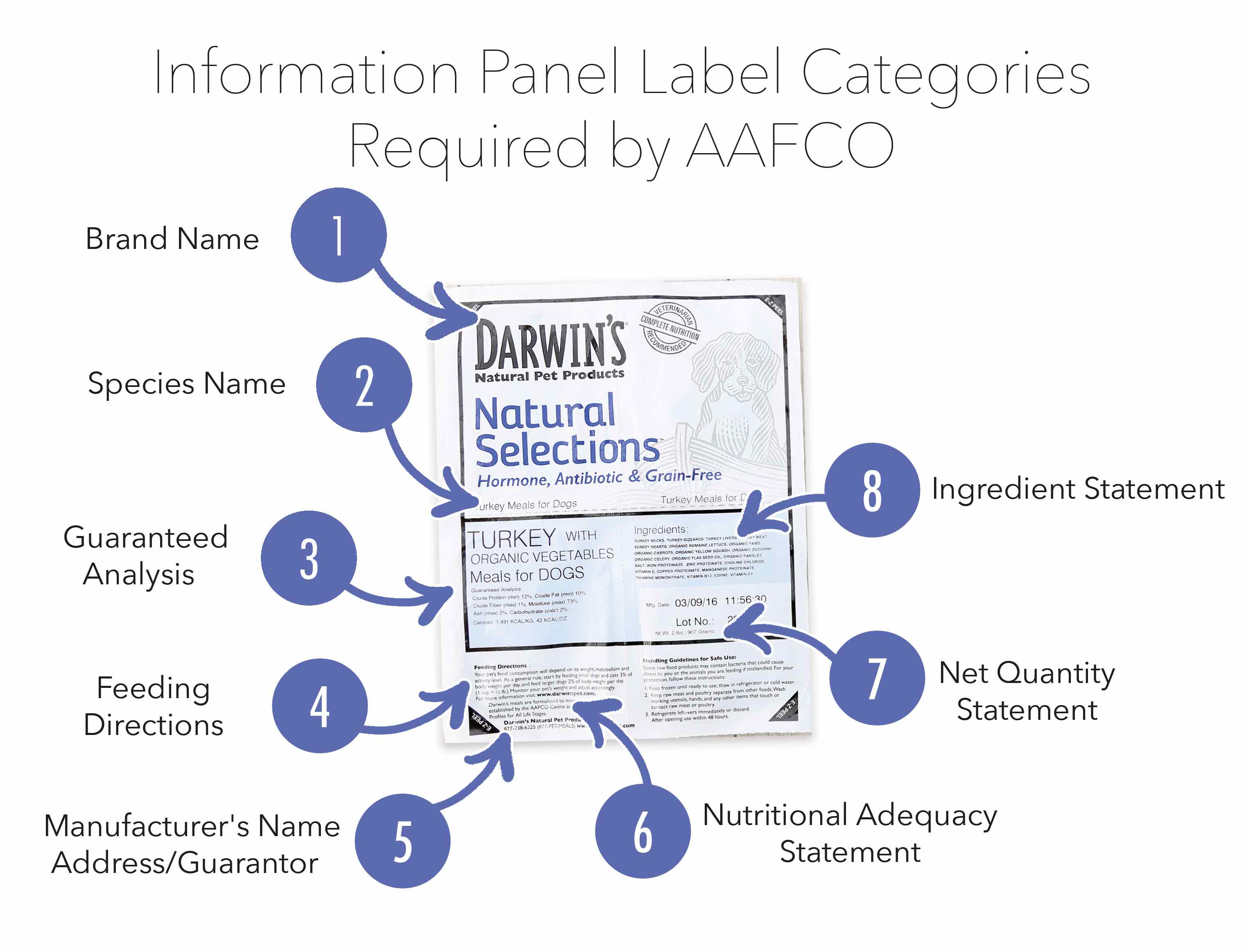
- Product Name and Brand Name: These rules address the use of ingredient names in the product name. How ingredients may be included in the product name depends on the percentage of an ingredient in the product, usually based on the type of protein, and can make evaluating meat or other content tricky for consumers. For example, a label of “Turkey Dog Food” requires 95 percent meat or more of the total weight of all ingredients. “Turkey Recipe Dog Food” requires that there’s at least 25 percent meat, but not more than 95 percent meat, and “Turkey Flavor Dog Food” has less than 3 percent total beef in the product.
- Species Name: The food must be identified as being for a dog, cat or other species food.
- Guaranteed Analysis: To advise buyers of the nutrient content of dog or other pet foods, labels provide maximum percentages of crude fiber and moisture and minimum percentages of crude protein and crude fat. Crude refers to the way materials are tested, as opposed to a reference about quality. Crude protein is the analysis of protein by measuring nitrogen; crude fat analyzes the lipid content of food, and crude fiber analyzes plant material.
- Feeding Directions: This section suggests what quantity to feed your pet daily based on body weight (pounds). The best method is to initially feed the directed amount, and then cut back or increase the amount to maintain adult body weight or reach proper weight gain for puppies. A nursing dog should be offered all the food she wants to eat. When in doubt, check with your vet for recommendations.
- Manufacturer’s Name and Address/Guarantor: This part of the label identifies the entity responsible for the quality and safety of the product and its location. Many manufacturers also include a toll-free number on the label for consumer inquiries.
- Nutritional Adequacy Statement: This indicates that the food is complete and balanced for a particular life stage or is intended for intermittent or supplemental feeding. Products conspicuously identified on the principal display panel as a supplement, treat or snack are exempt from including this information.
- Net Quantity Statement: This is how much product is in the container by net weight or net volume by units (pounds or ounces).
- Ingredient Statement: All ingredients are listed by weight. Ingredient weights are defined as they are added, including integral water content. Since meat is approximately 75 percent water, according to the FDA, without that water weight meat would likely take a lower position on the ingredient list. Rendered chicken, meat, or bone meal has most of the water and fat removed, which makes for more concentrated animal protein.
The information label isn’t the end of the story. There are other things to know about labeling before you decide to buy.
Understanding Dog Food Labels: Descriptive and Marketing Terms
In addition to facts and attractive graphics, labels—and pet food advertising—also employ descriptive and marketing terms. For the most part, these terms aren’t governed by regulations and have no legal or literal meaning. Here’s a quick look at some terms used on dog food labels and how to interpret them:

The key is to look past the “hype” and look at the hard facts around dog food ingredients.
More Details and Calculations to Consider When Reading Dog Food Labels
There are other factors that concerned dog owners should consider before making a purchase. You may want to check for the AAFCO guarantee, calorie, supplement, drug claims, and more:
- AAFCO Guarantee: AAFCO sets minimum standards for balanced and complete pet nutrition. While many pet owners and dog food experts may argue that there can be improvements made in the regulations, you can feel secure that if a dog food meets AAFCO guidelines, it will provide the nutrition that most dogs need. A product without AAFCO certification may be lacking as the single nutritional source for your dog.
- Calorie Information and Calculation: Calorie label statements aren’t mandatory, but are sometimes included. Pet foods can have very different calorie content, even if foods are of the same type. To compare a canned food against a dry food, use this simple calorie calculation: Multiply the value for the canned food by four to account for the higher water content of canned food versus the higher density of kibble-type products.
- Ingredients vs. Nutrients: Ingredients are the substances that provide nutrients, while nutrients are metabolically useful food components that support life. For example, bison is an ingredient that offers nutrients such as fatty acids, vitamins, and protein.
- Dietary Supplements: The FDA has taken the position that the Dietary Supplement Health and Education Act of 1994 (DSHEA) doesn’t apply to products for animals. American Veterinary Medical Association (AVMA) policy supports that position and doesn’t believe the act should be modified to include animals. In practice, vets prescribe supplements, supplements are marketed similarly to human supplements, and pet owners also use human supplements for their dogs.
- Drug Claims: Despite efforts to curtail drug claims, pet food products are marketed to treat or prevent disease. Veterinarians and pet owners should realize that such products rarely have undergone any studies to establish safety or efficacy. Products that state they’re for weight control, joint issues, dental health, or are hypoallergenic should be purchased with caution unless they are veterinary medical foods which have to meet AAFCO feeding trial protocols or nutrient profiles. The FDA has provided guidance on the criteria in regards to these types of drug claims. The presence of drug claims can result in rejection of registration, Stop-Sale letters, warning letters, and removal of products from the marketplace.
- Quantity and Dry Matter Basis Calculation: It’s up to the consumer to do the calculations to determine value and quantity when comparison shopping. How do you make apples-to-apples comparisons between dog foods? When comparing foods of different types (e.g., dry kibble to canned food and or raw frozen to kibble) products should be compared on a dry-matter basis. Dry foods contain about 10 percent water, while canned foods typically comprise about 75 percent water. Here’s how to calculate: Check the label for moisture percentage and subtract that from 100 percent. What remains is the percentage of dry matter. To find the dry-matter percentage of another nutrient, like fat, divide the percentage of fat by the percentage of dry matter.
- Salt: Sodium chloride is commonly added to pet foods as a flavor enhancer and preservative. Since dogs, like humans, enjoy the taste of salt, extra amounts are regularly added to dog foods to make them more appealing, although excessive salt has the same health implications for dogs as for humans. This is particularly important if your dog has a history of heart problems or high blood pressure. How much salt is too much? AAFCO recommends that dry dog food contain at least 0.3 percent sodium for both maintenance and to support healthy growth and development. These are minimum recommended levels. If salt is close to the top of the list of ingredients and you’re concerned about your pet’s salt intake, you may want to reconsider buying that particular brand.
Dog Food Labels: Ingredients and Descriptive Terminology
Many descriptive terms used on dog food labels have no official or legal definition and are marketing tools, such as “holistic.” Some terms do have a specific meaning (such as grain-free) that you should look for if your dog has particular nutritional needs. Here are some of the typical verbiage you may see on dog packaging and labels:

Much of what has been covered here relates to protein sources and protein byproducts. What about other types of foods often included in dog food?
Vegetables and Fruits in Dog Food
Steve Brown, Darwin’s consultant, author and expert on dog nutrition and the ancestral diet, stresses that plant matter has been part of dog diets for millennia. “Vegetables and other plant matter were part of the dog’s ancestral diet. Vegetables provide essential nutrients, including fiber, minerals, and vitamins. Without the plant matter providing those nutrients, an all-meat diet would need supplements. Vegetables can also help protect against certain forms of cancer.”
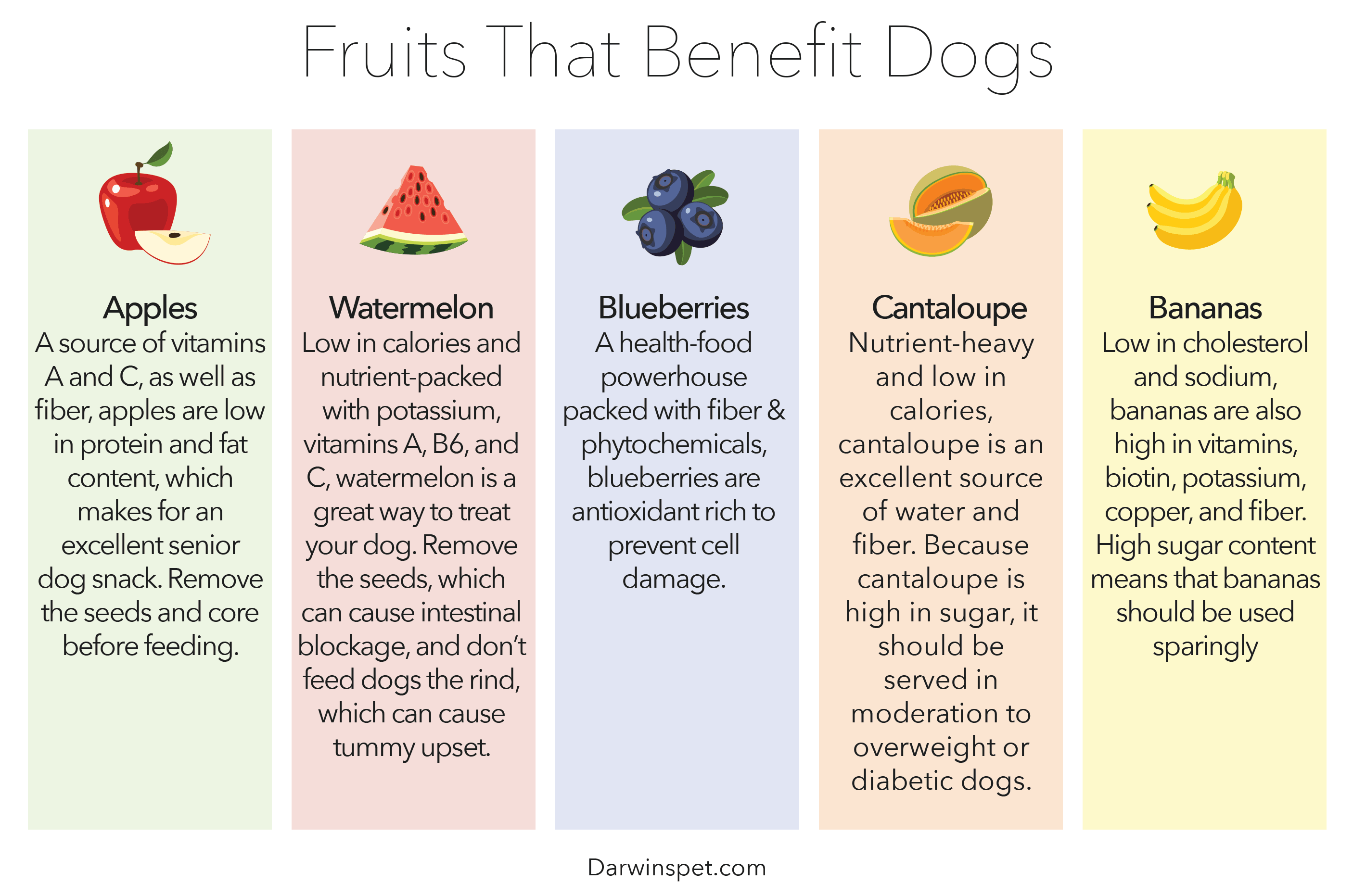
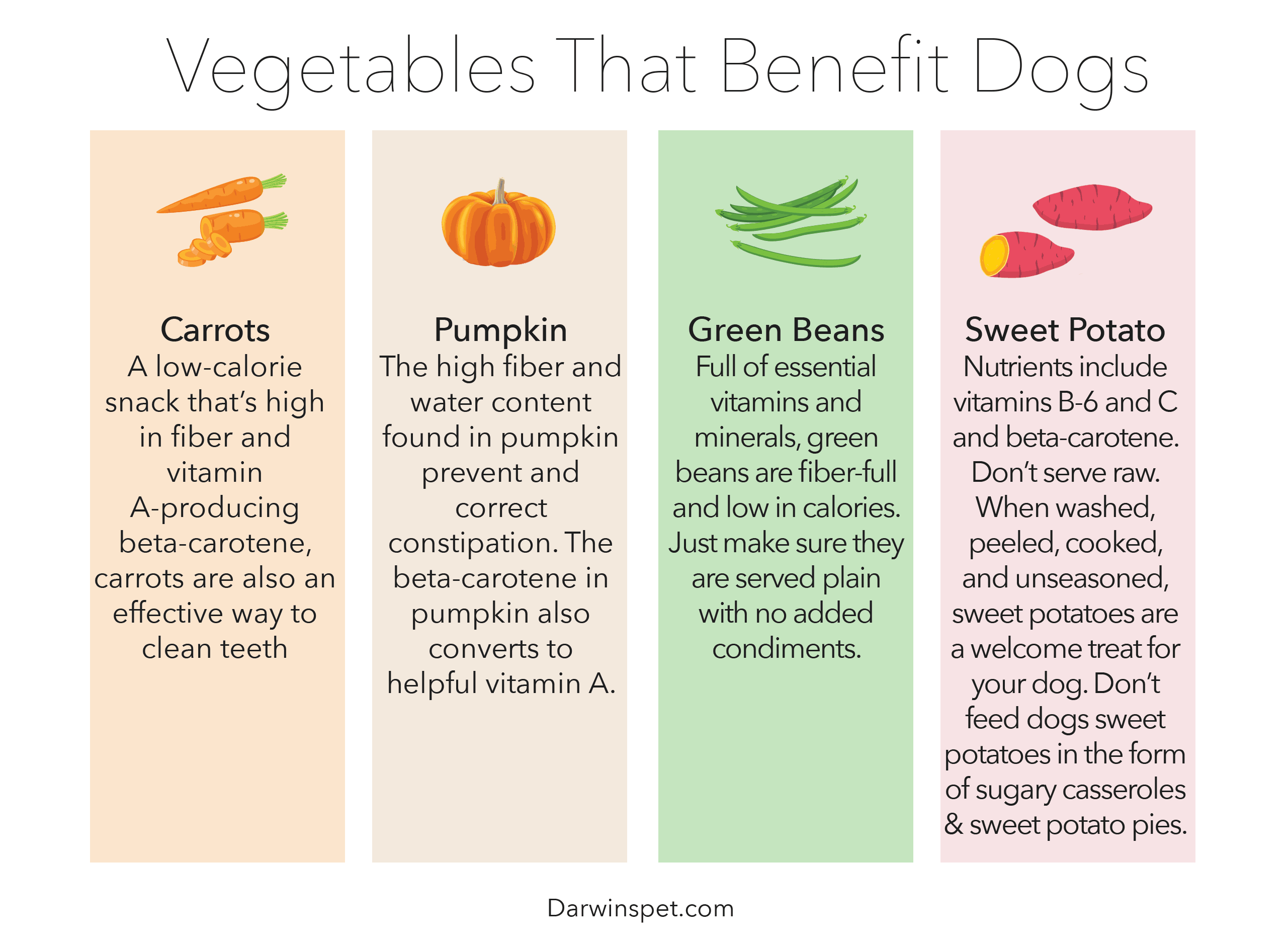
While fruits and vegetables are all fine for dogs, you don’t want to see all of these ingredients in one dog food product! The benefits of fiber are well known. Many dog owners know that providing fiber in their pet’s diet keeps bowel movements consistent and can prevent constipation and diarrhea. However, too much or too little fiber can disrupt your dog’s digestive tract. Typically, your dog should be getting about 5 percent crude fiber from either vegetables or fruits.
Dog Food Labels: Preservatives, Chemicals, and Other Additives
Health-conscious humans try to limit chemicals and artificial additives in their own diet and try to do the same when it comes to canine family members. Here are some common substances added to dog food:

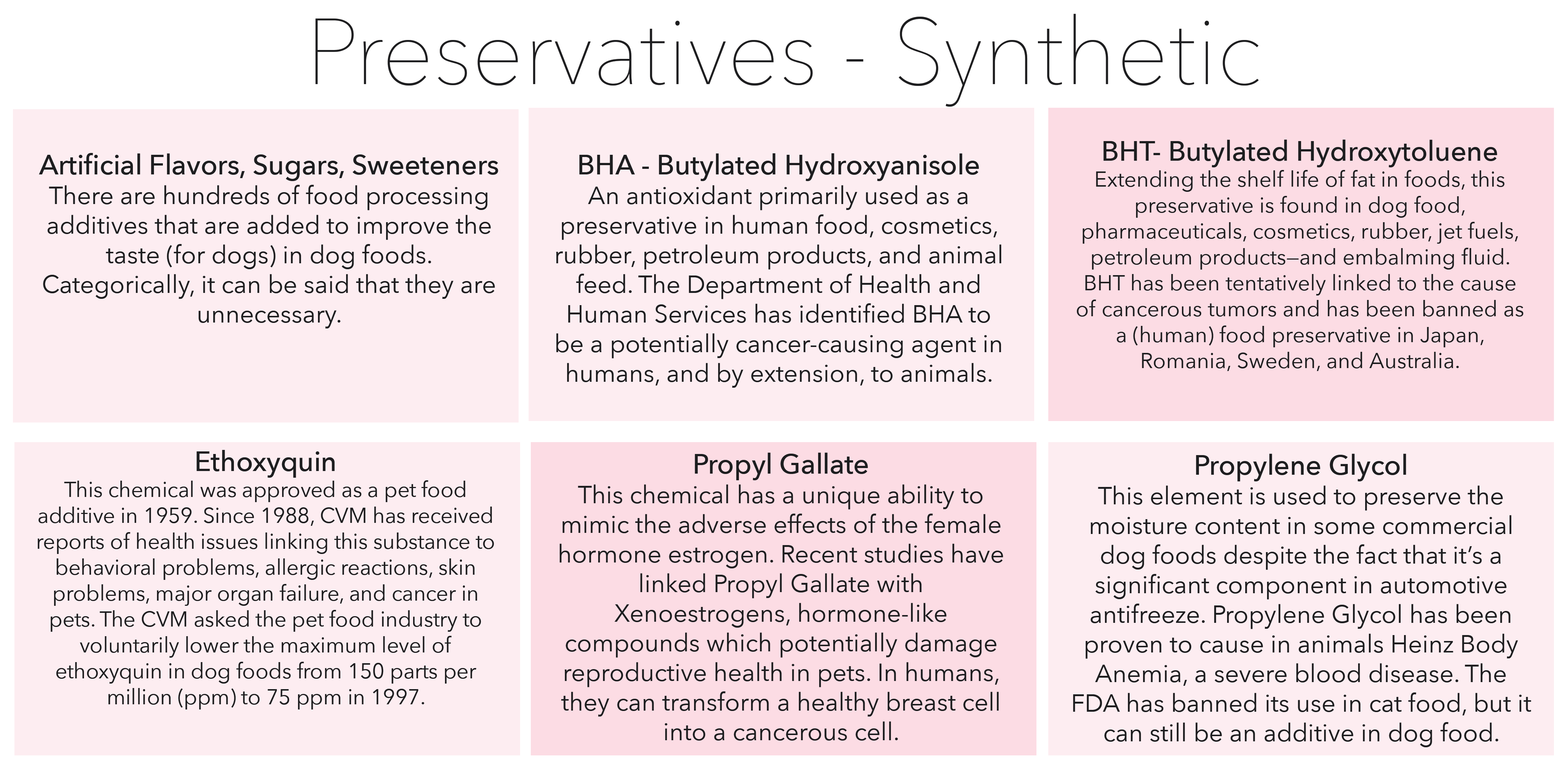

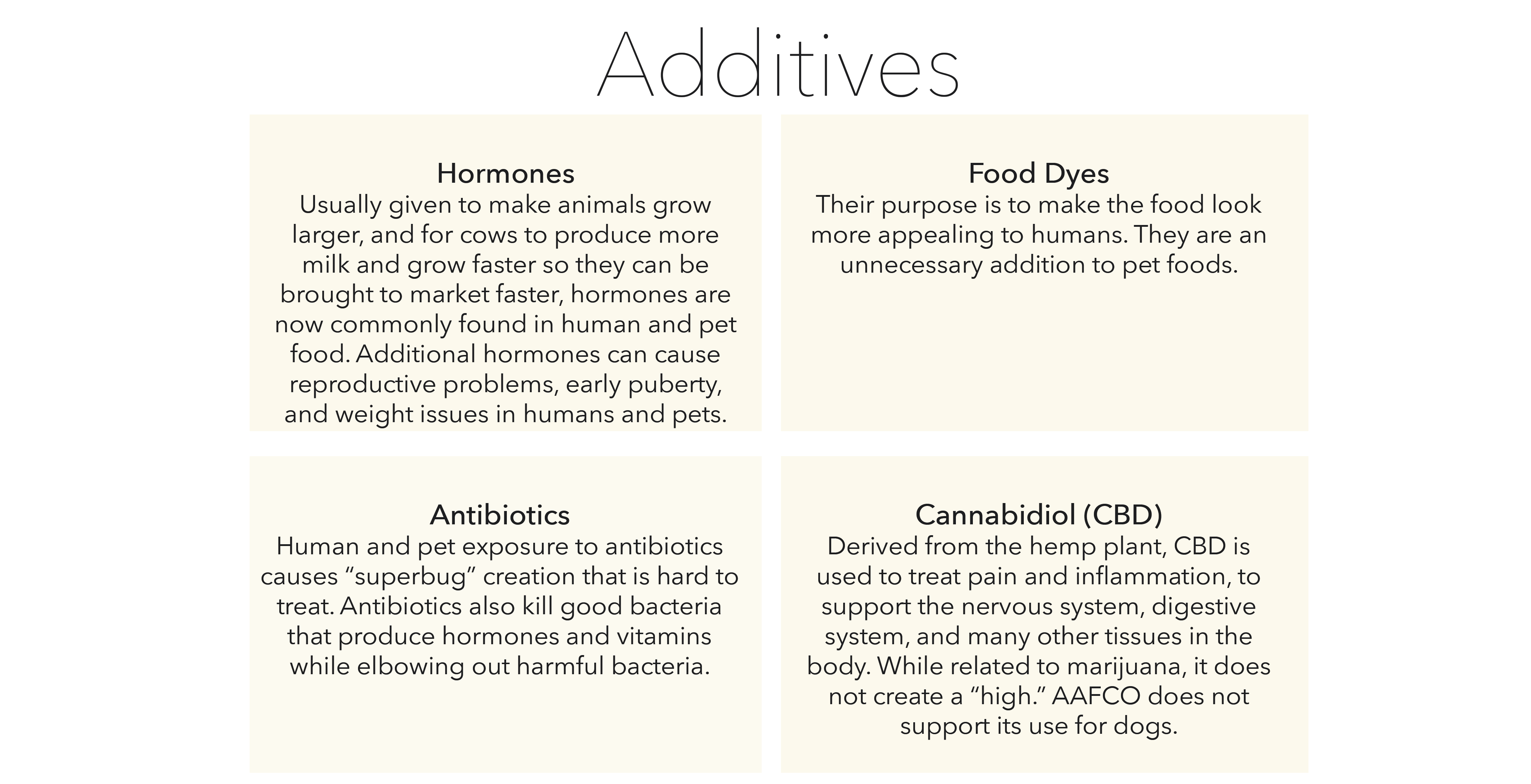
Compare Dog Food Labels
“I know a lot of people are mistrustful of dog food companies, big and small,” Coile notes. “I can tell you that having talked extensively with their researchers, and having visited dog food research facilities and dog food manufacturing facilities, my confidence in them has been boosted far beyond what it was before having done so.” While many dog foods are diligent about wholesome quality, it’s up to dog owners to buy carefully. Making apples-to-apples or meat-to-meat comparisons between dog food brands can be challenging. It’s easier if you can see everything that’s important to you in black and white.
Nutrition and Feeding Tips
“I look for meat content first,” Coile stresses. “As tempting as it is to get the highest of each, it depends on your dog and his age, weight and activity level, as well as any special health concerns.”
As we’ve seen, there can be a lot of marketing hype on packaging and in advertising, so it’s up to owners to do what’s best for their canine companions. Here are some practical ideas:
Buy for Your Dog’s Characteristics
Consider the breed, size, and age of your dog to decide what type (dry, wet, raw) of food is best suited to your pet. Your vet can make recommendations based on your dog’s characteristics.
Know Your Protein
There are different levels of quality in the protein included in dog food. Interested in more information? Look into High Protein Diets for Dogs, a resource that explains types of protein sources in detail. Animal proteins are more easily digested than soy and other proteins. Stressed or sick dogs may need more protein–let your veterinarian be your guide if your pup is under the weather.
Don’t Fear Fats
Balance is everything, and as is true for humans, some fat is necessary for life functions. For dogs, fats keep skin and coat healthy and are an energy source. Even if your dog is overweight, there still needs to be some fat in her diet.
When and How to Supplement
Dog diets that lack vitamins can lead to changes in behavior, greasy coat, thyroid problems, bone disorders or a weakened immune system. If any of these conditions are present, you shouldn’t default to guesswork; check with your vet and let them prescribe a food or standalone supplement to remedy the problem.
Think Balance
As far as food goes, a high volume of food isn’t necessary if it is easily digestible. A diet too rich in carbohydrates can cause digestive issues from bloating to constipation to excessive elimination—digestible dog food produces smaller stools. Even more dog-friendly options are meat, chicken, and fish-based foods, since vegetable-based protein is higher in carbohydrates. Water is essential, too. It keeps the digestive processes flowing. So, make sure your canine friend always has fresh, clean water available.
Keep it Fresh
Unless you make your dog’s food, it can be difficult to know how fresh the food is that your to your pet. You can check the “Best Before Date” required by AAFCO which indicates the shelf life of the product, or the date by which the food must be sold or removed for sale. BHA, BHT, and ethoxyquin preservatives last up to 18 months, but as previously noted, these chemicals can be harmful to a pet and should be avoided. Check for natural preservatives which keep dog food nutritionally sound from six to eight months. The “Best Before Date” doesn’t reveal is when the food was made, how fresh the food was when packaged, or how long it will stay fresh once you open the packaging. The exception to this rule is some refrigerated and frozen foods that include this information on the label.
Dog Food Freshness Tips:
- Kibble: Use kibble that has a base of beef or other red meat within three weeks of opening. Use chicken or white meat-based foods within two weeks of opening. Kibble deterioration occurs within six weeks. The fat that settles residually on the bottom of the container turns rancid after the date stamp and may cause diarrhea or vomiting when fed to your dog. If you use a container other than the original packaging, wash the empty container with soap and water before adding food from a new bag.
- Canned: Use canned food within three days of opening to provide optimum nutritional value for your pet. Always keep canned pet food refrigerated after opening.
- Refrigerated: Many dog foods now come refrigerated. Most refrigerated foods do have a use-by date. Always keep food in the refrigerator to prevent spoilage.
- Frozen: For pet food that’s cooked or frozen raw, thaw the food in the refrigerator, which usually takes about 12 hours. Keep any unused portions in the refrigerator and serve as soon as possible.
- Raw: Cover and store uneaten food in the refrigerator for safety. Washing meat isn’t necessary or recommended. However, it is important to wash your hands after handling raw meat or poultry or its packaging. Read Raw Dog Food: Is It the Right Choice for Your Pet? for more tips on feeding your pet raw dog food.
Coile notes that while taking care of our four-legged buddies is essential, she hopes that dog owners don’t worry too much about every single ingredient. “Everything has a balance,” she points out. “If I add more of one mineral to my dog’s nutrition, it may take away from another. You don’t need to weigh and balance every single gram of food.”
A positive approach is to remain well-informed and make the majority of the food you provide to your pet wholesome, health-supporting, and as fresh and chemical-free as possible. Perform due diligence to find products that meet high standards.
One of the best ways to provide fresh food to your dog is raw, frozen food that is reliably sourced—like Darwin’s.
Darwin’s: Proud of Our Fresh and Healthy Ingredients
Providing your canine with fresh, healthy, and quality raw meals is why we exist. Check out our Natural Selections™ meals which use only grass-fed, free-range beef, cage-free poultry, and organic vegetables.
- Free and Natural: If you’re looking for a non-GMO dog food that is free of hormones, steroids, and antibiotics, you can find it at Darwin’s. We visit every farm that raises the animals we use in our meals to make sure they employ sound farming practices and treat both their animals and employees with respect.
- Balanced: Our all-raw dog food meals are complete and balanced. Our dog foods are composed of 75 percent real meat and 25 percent fresh vegetables with a small amount of nutrient mix and valuable trace minerals.
- Grain-free: You won’t find grains in our dog food. We pay attention to research that has shown grains aren’t necessary for balanced canine nutrition and difficult for dogs to digest.
- AAFCO Compliant: Our moderate fat and low carbohydrate formula has a careful balance of Omega-6 and Omega-3 fatty acids, and essential minerals from natural or organic compounds to exceed the guidelines of both AAFCO and the National Research Council for canine nutrition.
At Darwin’s Pet Products, our number one goal is to help keep your pets healthy and active for as long as possible. To help accomplish this goal, we provide a library of articles in the hope of providing consumers with useful information to help their pets. And, primarily, we produce affordable, high-quality raw dog and cat meals which we ship directly to consumers so they are as fresh and convenient as possible. Our meals are high in protein, gluten-free, wheat-free, and are created to provide complete and balanced nutrition. We encourage you to learn more about our meals for dogs and meals for cats.
Or, if you think you might want a trial of Darwin’s (at an introductory price), we would love to send you our meals and hear how much your dog or cat loves them.



